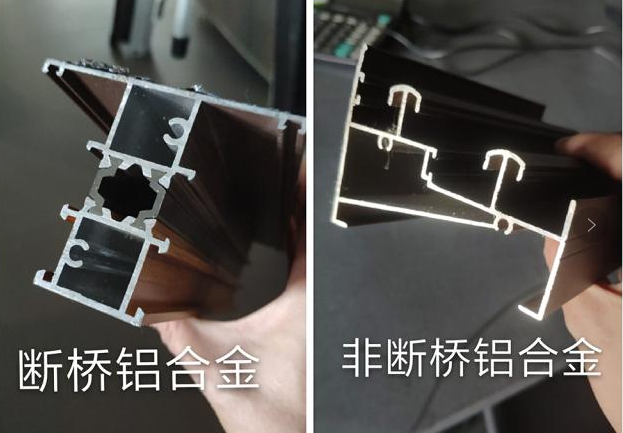Many owners often cannot distinguish the difference between broken bridge windows and non-broken bridge windows when purchasing building materials, and do not know which one is better to buy. In fact, there are both similarities and differences between the two. Next, let's look at the differences between broken bridge windows and non-broken bridge windows so that everyone can make a better choice when buying aluminium windows.

This is a cross-sectional view of aluminum alloy profiles. You should see which one is broken bridge aluminum at a glance. On the left is broken bridge aluminum profile. There is a black nylon heat insulation strip in the middle of the profile, which blocks the cold heat conduction inside and outside, it is called Broken Bridge aluminum, and its wall thickness is at least 1.4mm of the national standard, while the window made of this broken bridge aluminum is called bridge broken window. Most of them are flat doors and windows.
The profile on the right is aluminum alloy profile. It can be seen that there is no heat insulation nylon threading in the middle, and the wall thickness of the profile is only 1.2mm, so it can only be called ordinary aluminum alloy doors and windows, mostly sliding window.
Due to the strong thermal conductivity of aluminum alloy materials, heat energy can only be directly conducted through aluminum materials, while the aluminum alloy profile of the broken bridge window is cut off, aluminum alloy is on both sides of the aluminum profile, and heat insulation strip is in the middle of aluminum alloy on both sides. The heat insulation strip in aluminum can effectively reduce the transmission of heat energy and achieve the effect of effective heat insulation. However, the non-broken bridge window has no partition structure and is an integral aluminum alloy profile, so the thermal insulation performance of the non-broken bridge window will be worse than that of the broken bridge window.
The general material is the same. Casement window of the two are composed of aluminum alloy profiles, and the sound insulation effect is excellent. After testing, the sound insulation effect of broken bridge aluminum casement window and non-broken bridge aluminum casement window can reach 80% in the same place, it means that the outdoor noise is 90 decibels. When the doors and windows are closed, the indoor sound is about 35 decibels. In addition, the casement window appearance is the same, on the surface, people who are not in the door and window industry generally cannot see much difference. Bridge aluminum casement window is air-tight and watertight, with superior heat preservation performance. Double-layer hollow tempered glass is adopted to make casement window truly show sound insulation, heat insulation and insulation. What you may not know is, broken Bridge aluminum alloy casement window can help families save heating and cooling costs. The return in the later period greatly exceeds the previous investment. Energy-saving and environment-friendly doors and windows are broken bridge aluminum casement window.


